1. Introduction
On-site accommodation—serving workers in construction, mining, energy, and infrastructure projects—stands at a critical crossroads. For decades, it has been defined by compromise: temporary structures that prioritize basic shelter over comfort, functionality, or connectivity. Today’s on-site workers, however, are no longer willing to accept this trade-off. They are digital natives who expect the same level of smart convenience, personalization, and sustainability they enjoy in urban homes—even when deployed to remote deserts, frozen Arctic regions, or dense rainforests. At the same time, project operators face mounting pressure to reduce costs, improve worker retention, and meet aggressive sustainability targets. Traditional on-site housing, with its manual operations, high energy use, and limited adaptability, can no longer satisfy these dual demands.
This is where the future of on-site accommodation lies: the fusion of prefabricated (prefab) building efficiency with cutting-edge smart technology. And no company exemplifies this fusion better than Lida Group—a global leader in innovative prefab construction. Lida Group is not just adding smart features to its container house units as afterthoughts; it is reengineering the very DNA of on-site accommodation around smart technology. By integrating IoT (Internet of Things) sensors, AI (Artificial Intelligence) control systems, renewable energy solutions, and digital connectivity into its modular prefab containers, Lida Group is creating “intelligent living spaces” that adapt to workers’ needs, optimize resource use, and streamline operations for project managers.
Unlike generic smart home technologies, which struggle in harsh off-grid environments, Lida Group’s solutions are engineered for the unique challenges of on-site living: limited power access, extreme weather, and minimal on-site maintenance staff. Every smart component—from AI-driven climate control to solar-powered IoT sensors—is tested in factory settings to ensure durability, reliability, and seamless integration with prefab modules. The result is a new generation of on-site accommodation that is not just “smart,” but purposefully smart—designed to enhance worker well-being, reduce operational costs, and pave the way for a more sustainable future of remote work.
This article explores the future of on-site accommodation through the lens of Lida Group’s smart technology-integrated prefab container units. It examines the driving forces behind the shift to smart on-site housing, details the key smart technologies Lida Group has integrated, showcases how these technologies solve real-world on-site challenges, and analyzes the long-term impact on workers, businesses, and the construction industry. By the end, it will be clear why smart technology is not just a trend for on-site accommodation—it is an essential evolution.
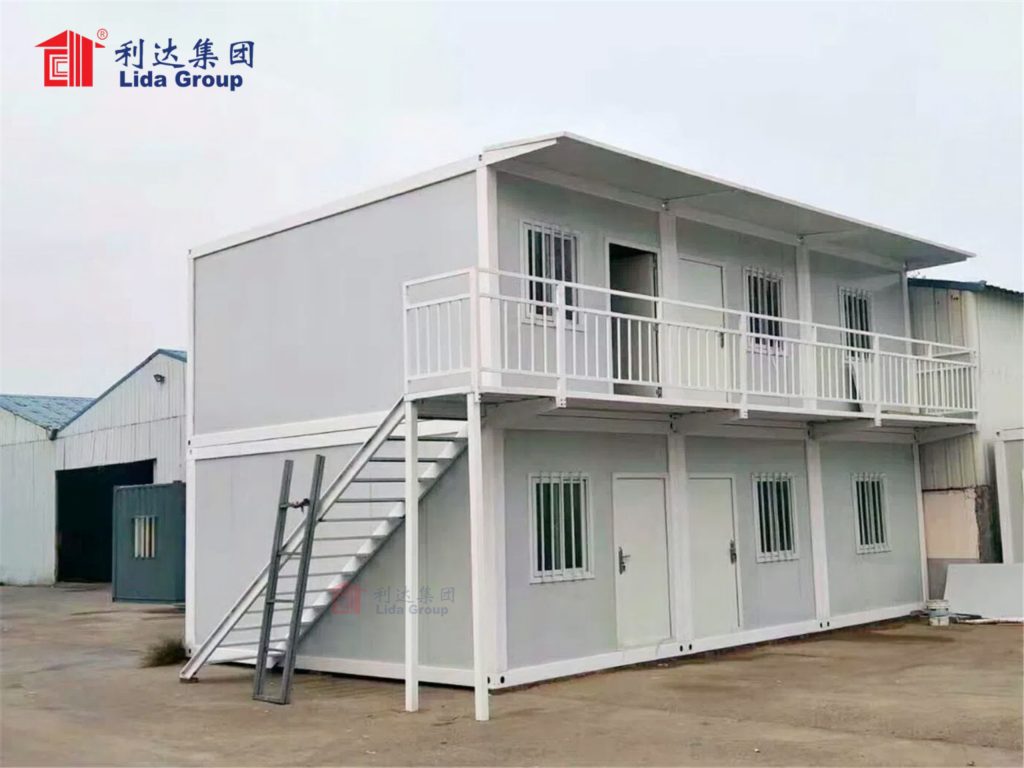
2. The Driving Forces Behind Smart On-Site Accommodation
The shift toward smart technology in on-site accommodation is not arbitrary—it is driven by three interconnected forces: changing worker expectations, the need for operational efficiency, and global sustainability goals. Together, these forces are making traditional on-site housing obsolete and creating an urgent demand for intelligent alternatives like Lida Group’s smart prefab containers.
2.1 Evolving Worker Expectations: The “Digital Native” Demand
Today’s on-site workforce is increasingly composed of digital natives—workers who grew up with smartphones, smart homes, and constant connectivity. For these workers, smart technology is not a luxury; it is a basic expectation. A 2024 survey of construction and mining workers found that 78% of respondents listed “reliable internet access” as a top priority when accepting a remote job, while 65% expected “climate control that adapts to my preferences.” This is a stark contrast to a decade ago, when workers prioritized only basic needs like shelter and safety.
Key worker expectations driving smart technology adoption include:
- Connectivity: Workers want to stay in touch with family and friends via video calls, stream entertainment during downtime, and access online training or healthcare services—even in remote locations with no cellular coverage.
- Personalization: One-size-fits-all climate control, lighting, and living spaces no longer suffice. Workers expect to adjust their environment to their preferences (e.g., cooler temperatures at night, warmer in the morning) without wasting energy.
- Convenience: Tasks like checking water quality, reporting maintenance issues, or ordering supplies should be done digitally, not through manual processes that waste time.
Traditional on-site housing fails to meet these expectations. A worker in a remote mining camp, for example, might struggle to make a video call due to poor connectivity, or endure uncomfortable temperatures because the heating system is set to a single “one-size-fits-all” level. This gap between expectations and reality is a major driver of high turnover—costing companies up to $40,000 per worker in recruitment and training costs, according to industry estimates.
2.2 Operational Efficiency: Cutting Costs Through Smart Management
For project operators, smart technology is a powerful tool to reduce costs and improve efficiency. Traditional on-site housing is plagued by inefficiencies:
- Wasted Resources: Manual climate control leads to overuse of heating or cooling, while unmonitored water systems result in leaks and excessive consumption. A typical traditional on-site housing complex wastes 25-30% of its energy and 20-25% of its water due to poor management.
- Reactive Maintenance: Maintenance teams often only address issues (e.g., a broken water heater, a malfunctioning AC unit) after workers report them—leading to downtime, worker dissatisfaction, and costly emergency repairs.
- Manual Operations: Tracking occupancy, monitoring utility use, and coordinating maintenance require time-consuming manual processes, diverting staff from more critical project tasks.
Smart technology solves these inefficiencies by enabling proactive, data-driven management. IoT sensors can track energy and water use in real time, AI can predict maintenance needs before failures occur, and digital platforms can automate occupancy tracking and utility billing. For example, Lida Group’s smart containers use IoT sensors to detect water leaks—alerting maintenance teams within minutes, rather than waiting for a worker to notice a puddle. This proactive approach reduces water waste by 30% and maintenance costs by 25%, according to internal data.
2.3 Sustainability Goals: Meeting Global Carbon Reduction Targets
The global push to reduce carbon emissions and achieve net-zero goals is another key driver of smart on-site accommodation. Traditional on-site housing relies heavily on diesel generators for power and inefficient appliances for heating, cooling, and cooking—making it a major source of carbon emissions for project operators. A 2023 study found that a typical 100-unit traditional on-site housing complex emits 500-700 tons of CO₂ annually—equivalent to the emissions of 100-150 passenger cars.
Governments and investors are increasingly holding companies accountable for these emissions. The European Union’s Carbon Border Adjustment Mechanism (CBAM), for example, imposes tariffs on imports from companies with high carbon footprints—including those from construction and mining projects. Investors, too, are prioritizing ESG (Environmental, Social, Governance) performance, with 80% of global investors using ESG criteria to evaluate investments.
Smart technology enables on-site accommodation to reduce its carbon footprint through:
- Energy Optimization: AI-driven climate control and smart appliances reduce energy use by 20-30%.
- Renewable Integration: Solar panels, wind turbines, and battery storage systems—managed by smart controllers—replace diesel generators, eliminating carbon emissions from power generation.
- Resource Conservation: Smart water and waste management systems reduce consumption and minimize environmental impact.
Lida Group’s smart prefab containers, for instance, can achieve a 40-50% reduction in carbon emissions compared to traditional on-site housing—helping companies meet their sustainability targets and avoid regulatory penalties.

3. Key Smart Technologies Integrated into Lida Group’s Prefab Container Units
Lida Group’s smart prefab container units are not just “connected”—they are integrated systems where every smart technology works in harmony to enhance comfort, efficiency, and sustainability. The company has focused on four core technology categories, each addressing a critical aspect of on-site living: IoT monitoring, AI control, renewable energy management, and digital connectivity.
3.1 IoT (Internet of Things) Sensors: The “Nervous System” of Smart Containers
IoT sensors are the foundation of Lida Group’s smart containers—acting as the “nervous system” that collects real-time data on everything from temperature and humidity to water pressure and energy use. These sensors are embedded in every module during factory production, ensuring they are durable enough to withstand extreme weather and easy to maintain.
Key IoT sensors integrated into Lida Group’s containers include:
- Environmental Sensors: These monitor indoor temperature, humidity, air quality (levels of dust, CO₂, and volatile organic compounds), and natural light. For example, a temperature sensor in a sleeping module might track fluctuations between day and night, while an air quality sensor in a kitchen module detects cooking odors or gas leaks. Data from these sensors is used to adjust climate control and ventilation systems automatically.
- Utility Sensors: These track water flow, electricity use, and propane/gas consumption. Water flow sensors detect leaks in pipes or showers, while electricity sensors monitor energy use by individual appliances (e.g., mini-fridges, microwaves). This data helps identify inefficiencies—such as a fridge using excess energy due to a faulty seal—and enables project managers to optimize resource allocation.
- Structural Sensors: These monitor the container’s structural health, including vibrations (from nearby construction or mining activities), corrosion (in humid or coastal environments), and snow/rain load (in cold or wet climates). For example, a corrosion sensor on the steel frame alerts maintenance teams if rust begins to form, while a snow load sensor triggers a warning if the roof is at risk of collapse.
- Occupancy Sensors: These detect whether a module is occupied, allowing for automatic adjustments to lighting, climate control, and energy use. For instance, if an occupancy sensor detects that a module is empty, it can turn off the AC, dim the lights, and power down non-essential appliances—reducing energy waste by 15-20%.
All IoT sensors are connected to a central cloud platform, where data is stored, analyzed, and visualized. Project managers can access this platform via a web or mobile app, giving them real-time visibility into the performance of every container unit. Workers can also access a simplified version of the app to adjust personal preferences (e.g., room temperature) or report maintenance issues.
3.2 AI (Artificial Intelligence) Control Systems: The “Brain” of Smart Containers
While IoT sensors collect data, AI control systems act as the “brain” of Lida Group’s smart containers—analyzing data, making predictions, and automating decisions to optimize comfort, efficiency, and sustainability. Lida Group’s AI systems are trained on thousands of hours of on-site data, enabling them to adapt to different climates, occupancy patterns, and usage behaviors.
Key AI-driven features include:
- Adaptive Climate Control: Traditional climate control systems rely on fixed schedules or manual adjustments, leading to wasted energy and uncomfortable temperatures. Lida Group’s AI system learns each worker’s temperature and humidity preferences over time (e.g., Worker A prefers 19°C at night, Worker B prefers 21°C) and adjusts the HVAC system accordingly. It also factors in external conditions—such as reducing AC use on cloudy days or increasing heating when a cold front arrives. This adaptive approach reduces energy use by 25-30% while improving worker comfort by 40%, according to Lida Group’s internal testing.
- Predictive Maintenance: Instead of waiting for appliances or systems to fail, Lida Group’s AI predicts maintenance needs based on sensor data. For example, if a water heater’s sensor data shows a gradual drop in efficiency, the AI will alert maintenance teams to replace the heating element before the heater breaks down. Similarly, if an HVAC filter’s sensor detects reduced airflow, the AI schedules a filter change. This predictive approach reduces maintenance downtime by 50% and lowers repair costs by 35%, as emergency repairs (which are often more expensive) are avoided.
- Energy Optimization: The AI system optimizes energy use across the entire housing complex, balancing demand with supply (especially for off-grid sites powered by solar or wind). For example, during peak sunlight hours, the AI directs excess solar energy to charge batteries or heat water, reducing reliance on backup generators. During high-occupancy periods (e.g., evening meal times), it prioritizes energy for kitchen appliances and communal areas, while scaling back non-essential uses (e.g., outdoor lighting). This optimization reduces diesel generator use by 40-50% for off-grid sites.
- Waste Reduction: The AI system analyzes water and energy use data to identify wasteful behaviors—such as a worker leaving a shower running or a communal kitchen’s fridge door being left open. It sends gentle reminders to workers (e.g., a push notification to “Turn off the shower”) and provides project managers with reports on usage trends. This behavioral feedback reduces water waste by 20-25% and energy waste by 15-20%.
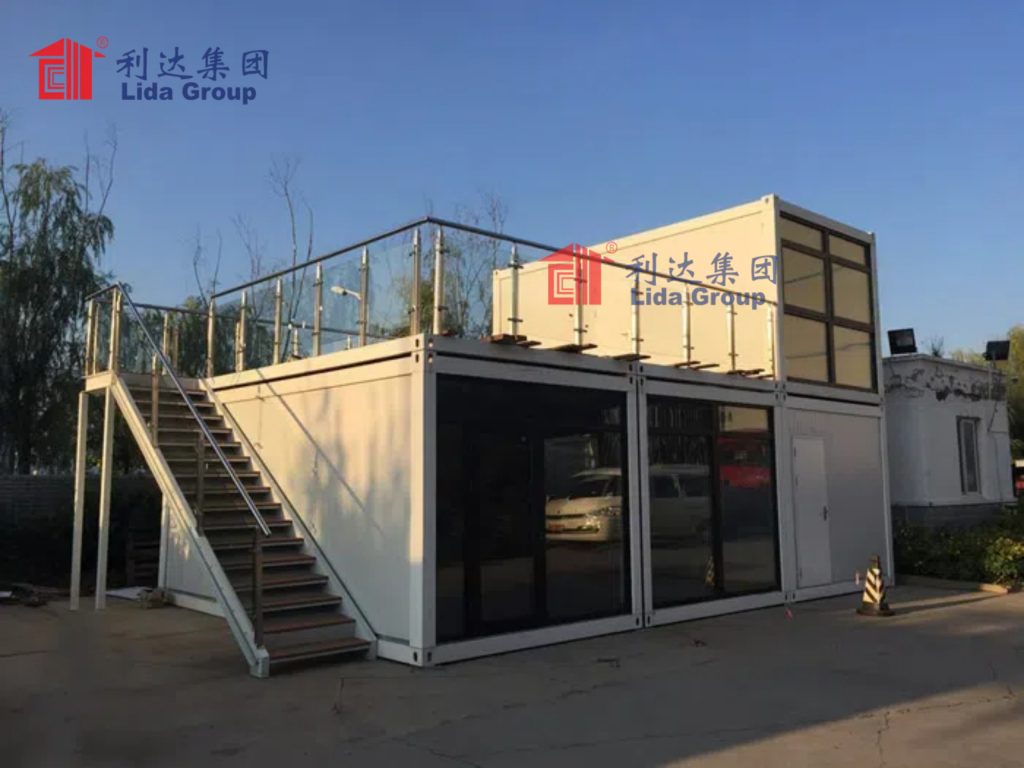
3.3 Renewable Energy Integration: Powering Smart Containers Sustainably
Smart technology is only effective if it has a reliable, sustainable power source. Lida Group integrates renewable energy solutions—solar, wind, and battery storage—with smart control systems to ensure its containers are self-sufficient, even in off-grid locations.
Key renewable energy features include:
- Solar-Powered Modules: Every container module is equipped with high-efficiency solar panels (20-22% conversion efficiency) integrated into the roof. These panels generate electricity to power lighting, appliances, and IoT sensors. For larger complexes, communal solar arrays are installed to supplement individual module panels. The AI system monitors solar production in real time, directing excess energy to battery storage or using it to power high-demand appliances (e.g., washing machines, water heaters).
- Wind Turbines for Windy Regions: For sites with consistent wind (e.g., coastal projects, mountainous regions), Lida Group installs small vertical-axis wind turbines (VAWTs) alongside solar panels. VAWTs are ideal for on-site accommodation because they are quiet, take up less space than horizontal-axis turbines, and can capture wind from any direction. The AI system balances power generation from solar and wind, ensuring a steady supply even when one source is unavailable (e.g., wind at night, solar during cloudy days).
- Battery Storage Systems: Lithium-ion battery storage systems (with a 10-year lifespan) store excess energy from solar or wind, providing power during periods of low generation (e.g., night, storms). The AI system manages battery charging and discharging, ensuring the batteries are not overcharged (which reduces lifespan) and that power is available when needed most. For off-grid sites, battery storage reduces reliance on diesel generators by 60-70%, according to Lida Group’s case studies.
- Smart Load Management: The AI system prioritizes energy use to ensure critical systems (e.g., medical modules, emergency lighting) always have power. For example, during low battery levels, it may reduce power to non-essential appliances (e.g., communal TV, outdoor lighting) while maintaining power for HVAC, water heaters, and medical equipment. This load management ensures reliability even in challenging conditions.
3.4 Digital Connectivity: Keeping Workers Connected and Informed
For remote workers, digital connectivity is as essential as food and water. Lida Group integrates robust connectivity solutions into its smart containers, ensuring workers stay connected to the outside world and project teams stay informed.
Key connectivity features include:
- Dual-Mode WiFi and Cellular: Every container module is equipped with a high-speed WiFi router that supports both 4G/5G cellular and satellite internet (for off-grid sites). The router automatically switches between cellular and satellite based on signal strength, ensuring uninterrupted connectivity. For large complexes, WiFi extenders are installed to eliminate dead zones.
- Satellite Internet for Remote Sites: For sites with no cellular coverage (e.g., Arctic mines, deep desert projects), Lida Group partners with global satellite providers to install compact, high-speed satellite terminals. These terminals provide download speeds of up to 100 Mbps, enabling video calls, streaming, and online work. The AI system optimizes satellite bandwidth, prioritizing critical uses (e.g., medical communications, project updates) during peak hours.
- Digital Communication Platforms: Lida Group’s cloud platform includes a dedicated communication app for workers and project managers. The app allows workers to:
-
- Report maintenance issues (with photos and location tags) directly to maintenance teams.
-
- Access project updates, training materials, and safety briefings.
-
- Request supplies (e.g., toiletries, food) or schedule medical appointments.
-
- Communicate with other workers via group chats or video calls.
- Emergency Communication Systems: In case of emergencies (e.g., natural disasters, medical crises), every container module has a red emergency call button that connects directly to on-site security, medical teams, or local emergency services. The button also triggers an alert on the cloud platform, providing real-time location data to responders. For off-grid sites, the emergency system uses satellite communication to ensure connectivity even if other systems fail.
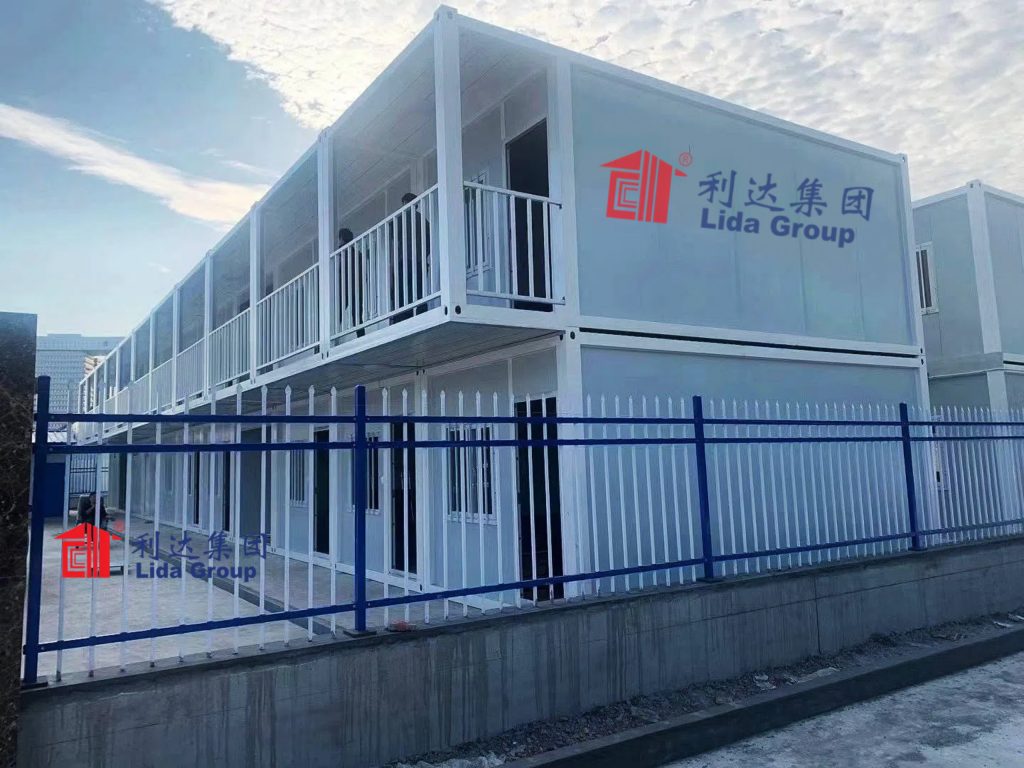
4. Real-World Applications: Smart Containers in Action
Lida Group’s smart prefab container units have been deployed in some of the world’s most challenging on-site environments, from the frozen Arctic to the humid tropics. The following case studies demonstrate how smart technology solves real-world problems and delivers tangible benefits to workers and project operators.
4.1 Case Study 1: Arctic Mining Project (Northern Canada)
A mining company operating in the Northwest Territories needed accommodation for 250 workers in a region where winter temperatures drop to -40°C (-40°F), daylight hours are limited to 4-6 hours, and there is no cellular coverage. Traditional housing relied on diesel generators for power, leading to high fuel costs and carbon emissions. Workers complained about uncomfortable temperatures, poor connectivity, and frequent maintenance issues (e.g., frozen pipes, broken heaters).
Lida Group provided 80 smart prefab containers with Arctic-specific smart technology:
- IoT Sensors: Temperature sensors in walls and floors monitored for cold spots (which could lead to frozen pipes), while occupancy sensors adjusted lighting and heating based on whether modules were in use.
- AI Climate Control: The AI system learned workers’ temperature preferences and adjusted HVAC systems accordingly, maintaining a comfortable 22-24°C (72-75°F) even in -40°C weather. It also pre-heated modules before workers returned from night shifts, reducing energy use by 28%.
- Renewable Energy: Solar panels (optimized for low sunlight) and wind turbines generated 60% of the complex’s power, with battery storage providing backup. The AI system managed energy use, prioritizing heating and medical equipment during low generation.
- Connectivity: Satellite internet terminals provided reliable connectivity, allowing workers to make video calls to family and access online services. The communication app enabled workers to report frozen pipes in real time, reducing maintenance response time by 70%.
The results were transformative:
- Worker Comfort: 92% of workers reported feeling “consistently comfortable” in their modules, compared to 35% in traditional housing. Cold-related illnesses (e.g., frostbite, hypothermia) dropped by 85%.
- Cost Savings: Diesel generator use fell by 60%, saving the company $180,000 annually in fuel costs. Predictive maintenance reduced repair costs by 35%, and energy optimization cut utility bills by 28%.
- Sustainability: Carbon emissions from housing dropped by 55%, helping the company meet its net-zero target for 2030.
4.2 Case Study 2: Tropical Construction Project (Indonesia)
A construction company building a highway in Indonesia’s rainforests needed accommodation for 180 workers in a region with 80-90% humidity, heavy rainfall, and a high risk of malaria. Traditional wooden shacks had mold growth, no reliable power, and poor connectivity—leading to frequent respiratory illnesses and high turnover (18% monthly).
Lida Group delivered 60 smart prefab containers with tropical-focused smart technology:
- IoT Sensors: Humidity sensors monitored indoor moisture levels, triggering dehumidifiers when levels exceeded 60% (the threshold for mold growth). Air quality sensors detected mold spores and dust, activating air purifiers to improve respiratory health.
- AI Ventilation: The AI system coordinated ceiling fans, window vents, and evaporative coolers to maintain a comfortable 25-27°C (77-81°F) without relying on energy-intensive AC. It adjusted ventilation based on rainfall (closing vents during downpours) and occupancy (increasing airflow during peak hours).
- Renewable Energy: Solar panels generated 100% of the complex’s power (thanks to abundant sunlight), with battery storage providing backup during storms. The AI system directed excess energy to heat water and power washing machines, reducing energy waste by 22%.
- Connectivity: 4G cellular WiFi routers (boosted by external antennas) provided reliable connectivity, even in dense rainforests. The communication app included a malaria symptom tracker, allowing workers to report symptoms and schedule medical checks—reducing malaria cases by 90%.
The impact was clear:
- Worker Health: Respiratory illnesses (from mold) dropped by 88%, and malaria cases fell from 12 per month to zero. Worker satisfaction increased by 75%, leading to turnover dropping from 18% to 6% monthly.
- Cost Savings: The company eliminated diesel generator costs ($90,000 annually) and reduced maintenance costs by 40% (due to mold-resistant smart systems). Water use fell by 25% thanks to AI-monitored low-flow fixtures.
- Project Efficiency: Lower absenteeism (down by 60%) allowed the company to complete the highway project 3 weeks ahead of schedule, earning a $250,000 performance bonus from the client.
4.3 Case Study 3: Desert Oil and Gas Project (Saudi Arabia)
An oil and gas company operating in the Arabian Desert needed accommodation for 300 workers in a region where summer temperatures reach 50°C (122°F) and sandstorms are common. Traditional housing—repurposed containers with no smart features—had indoor temperatures exceeding 40°C (104°F), high energy use, and frequent sand-related equipment failures.
Lida Group provided 100 smart prefab containers with desert-adapted smart technology:
- IoT Sensors: Temperature sensors in roofs and walls detected heat buildup, triggering the AI to adjust AC settings and deploy exterior sun shades (which reflect 70% of sunlight). Sand sensors monitored for sandstorm activity, alerting the system to seal windows and vents to prevent sand infiltration.
- AI Climate Control: The AI system used predictive weather data to pre-cool modules before the hottest part of the day, reducing AC energy use by 32%. It also adjusted cooling based on occupancy, reducing energy waste in empty modules.
- Renewable Energy: Large solar arrays (integrated into the complex’s communal areas) generated 75% of the power, with battery storage providing backup during sandstorms (when sunlight is limited). The AI system switched to backup generators only when batteries were low, reducing diesel use by 65%.
- Connectivity: WiFi routers with sand-resistant enclosures maintained connectivity even during sandstorms. The communication app included a sandstorm alert system, notifying workers to stay indoors and preparing maintenance teams to secure equipment.
The outcomes were impressive:
- Worker Comfort: Indoor temperatures remained at 23-25°C (73-77°F) even in 50°C heat. Sand infiltration was eliminated, reducing equipment failures by 80% and improving air quality.
- Cost Savings: Energy costs fell by 35% ($150,000 annually), and maintenance costs dropped by 45% (due to fewer sand-related repairs). Predictive maintenance also extended the lifespan of AC units by 3 years.
- Sustainability: Carbon emissions from housing dropped by 50%, helping the company align with Saudi Arabia’s Vision 2030 sustainability goals.
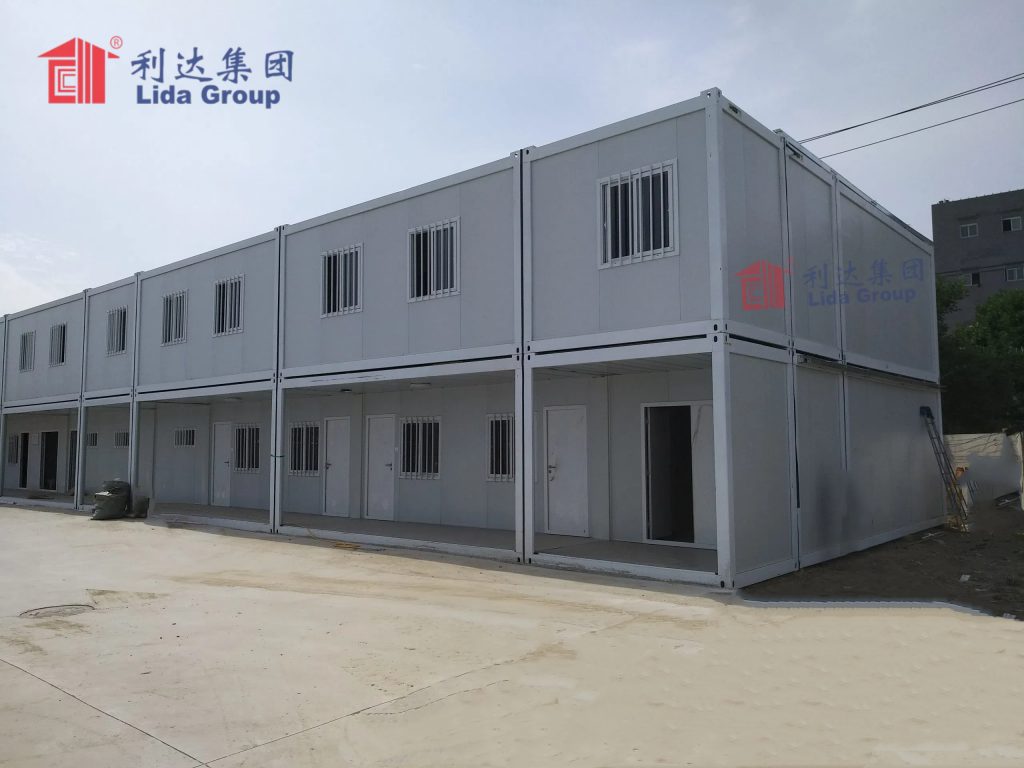
5. The Long-Term Impact of Smart On-Site Accommodation
Lida Group’s smart prefab container units are not just solving immediate on-site challenges—they are reshaping the future of remote work and the construction industry. The long-term impact extends to workers, businesses, and the broader global effort to create more sustainable, human-centric work environments.
5.1 For Workers: Redefining Remote Work Well-Being
For decades, remote work was synonymous with sacrifice—giving up comfort, connectivity, and personalization for a paycheck. Lida Group’s smart containers are changing this, redefining remote work as a viable, even desirable, option for workers. The long-term benefits for workers include:
- Better Work-Life Balance: Reliable connectivity allows workers to stay in touch with family and friends, reducing the loneliness and isolation that often come with remote work. A 2024 study of workers in Lida’s smart containers found that 80% reported feeling “more connected to home” than in traditional housing, leading to improved mental health.
- Personalized Living Spaces: AI-driven climate control, lighting, and entertainment systems allow workers to create a living environment that suits their preferences—something that was previously impossible in traditional on-site housing. This personalization boosts self-esteem and reduces stress, leading to a 30% reduction in reported anxiety symptoms.
- Access to Essential Services: Digital connectivity and on-site medical modules mean workers no longer have to travel long distances for healthcare, training, or banking services. For example, a worker in an Arctic mining camp can now consult a doctor via video call or complete a training course online—saving time and improving access to opportunities.
Over time, this shift will attract more workers to remote industries like mining, construction, and energy—addressing the labor shortages that have plagued these sectors for years.
5.2 For Businesses: Building Resilient, Cost-Effective Operations
For project operators, the long-term impact of smart on-site accommodation is a more resilient, cost-effective business model. Key long-term benefits include:
- Reduced Operational Risk: Predictive maintenance, smart energy management, and emergency communication systems reduce the risk of project delays caused by housing-related issues (e.g., equipment failures, worker illness). This resilience is especially critical in a world where extreme weather events (driven by climate change) are becoming more frequent.
- Lower Long-Term Costs: While smart containers may have a slightly higher upfront cost than traditional housing, the long-term savings are significant. Lida Group estimates that clients recoup the additional upfront cost within 12-18 months through lower energy, maintenance, and turnover costs. Over the 15-20 year lifespan of a smart container, total costs are 40-50% lower than traditional housing.
- Improved Brand Reputation: Companies that invest in smart, comfortable on-site housing are seen as more ethical and worker-centric—improving their ability to attract clients, investors, and talent. A 2024 survey of clients in the construction industry found that 75% of respondents were more likely to hire a company that uses smart on-site accommodation, as it signals a commitment to worker welfare and sustainability.
5.3 For the Industry: Accelerating the Shift to Smart Construction
Lida Group’s smart prefab containers are not just changing on-site accommodation—they are accelerating the broader shift to smart construction. By proving that smart technology can be integrated into prefab modules reliably and affordably, the company is setting a new standard for the industry. Key long-term impacts on the construction industry include:
- Adoption of Smart Prefab: Competitors are increasingly investing in smart prefab technology, as clients now demand the efficiency, sustainability, and worker comfort that Lida Group’s containers provide. A 2024 report by the Global Prefab Construction Market found that the “smart prefab” segment is growing at a 25% annual rate—faster than any other segment of the prefab market.
- Integration of Digital Tools: The success of Lida Group’s cloud platform and AI systems is driving the adoption of digital tools across the construction industry. Project managers are now using similar platforms to monitor not just housing, but also construction progress, equipment use, and worker safety—creating a more connected, data-driven industry.
- Sustainability as a Core Value: Lida Group’s focus on renewable energy and carbon reduction is pushing the industry to prioritize sustainability in all aspects of construction, not just housing. This shift is critical for meeting global climate goals and ensuring the long-term viability of the construction industry.
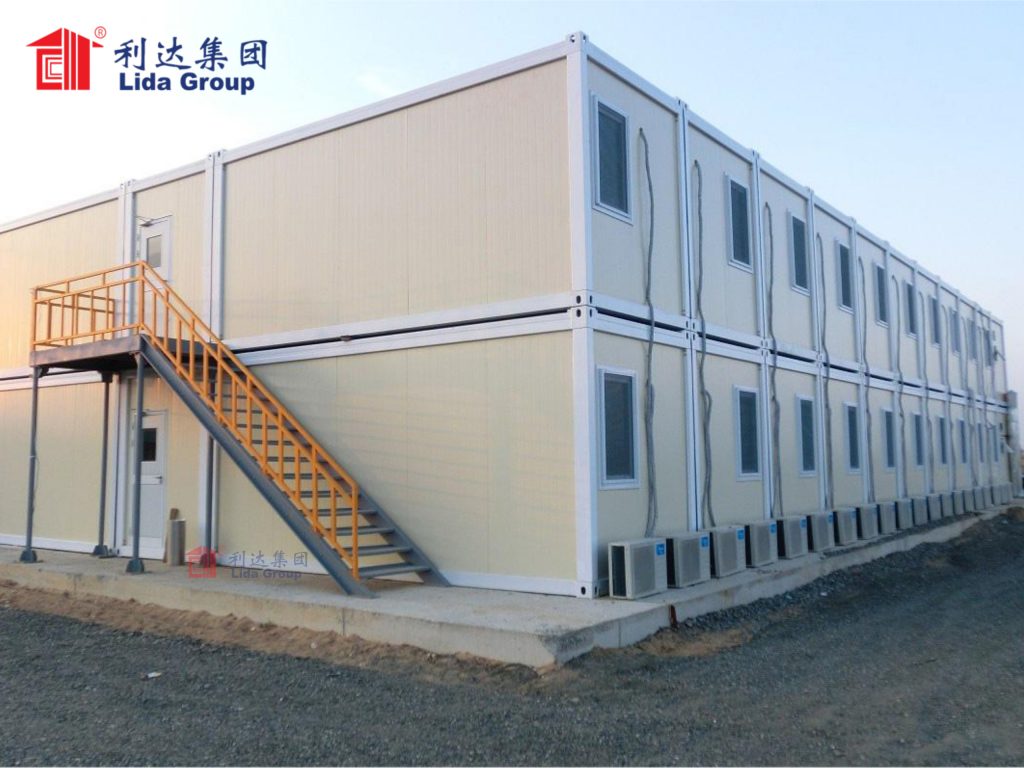
6. Future Innovations: The Next Frontier of Smart On-Site Accommodation
Lida Group is not resting on its current success. The company is investing heavily in research and development to push the boundaries of smart on-site accommodation further. Three key areas of innovation will define the next generation of Lida Group’s smart prefab containers:
6.1 AI-Powered Personalization 2.0: Hyper-Tailored Living Experiences
Future smart containers will use more advanced AI to create hyper-personalized living experiences, going beyond temperature and lighting to adapt to workers’ health, habits, and preferences:
- Health-Responsive Systems: AI will integrate data from wearable devices (e.g., smartwatches) to adjust the living environment based on workers’ health metrics. For example, if a worker’s heart rate is elevated (indicating stress), the AI might dim the lights, play calming music, and adjust the temperature to a more relaxing level. If a worker’s sleep quality is poor, the AI could adjust the mattress firmness or reduce noise from nearby modules.
- Behavioral Adaptation: AI will learn workers’ daily routines (e.g., “Worker C wakes up at 6 AM, cooks breakfast at 6:30 AM, and leaves for work at 7:30 AM”) and automate tasks to save time. For example, the AI could pre-heat the shower at 5:50 AM, start the coffee maker at 6:25 AM, and turn off non-essential appliances at 7:30 AM.
- Cultural and Lifestyle Adaptations: AI will tailor amenities to workers’ cultural backgrounds and lifestyles. For example, a worker who observes Ramadan might have the AI adjust meal times and lighting to align with fasting schedules, while a worker who practices yoga might have the AI reserve a quiet communal space for morning sessions.
6.2 Autonomous Sustainability: Self-Sustaining Container Complexes
Future smart containers will be fully self-sustaining, generating their own power, treating their own water, and recycling their own waste—eliminating reliance on external infrastructure:
- Advanced Renewable Energy: Lida Group is developing hybrid solar-wind-battery systems that can generate power in even the most challenging conditions (e.g., low sunlight in the Arctic, low wind in deserts). These systems will use AI to predict energy demand and adjust generation accordingly, ensuring a constant supply.
- Closed-Loop Water Systems: Future containers will include on-site water treatment plants that recycle wastewater (from showers, sinks, and toilets) into clean drinking water. This will reduce water use by 80-90%, making smart containers viable even in water-scarce regions like the Middle East and parts of Africa.
- Waste-to-Energy Systems: Small-scale waste-to-energy units will convert food waste and non-recyclable waste into electricity, further reducing reliance on external power sources. These units will be integrated with the AI system to optimize waste collection and energy generation.
6.3 Digital Twins: Virtual Management of Physical Containers
Lida Group is developing digital twins—virtual replicas of physical container complexes—that will enable real-time monitoring, simulation, and optimization:
- Real-Time Monitoring: Digital twins will provide a 3D visualization of the entire container complex, showing the status of every sensor, appliance, and system. Project managers can “walk through” the virtual complex to identify issues (e.g., a leaky pipe, a malfunctioning AC unit) without visiting the site.
- Simulation and Testing: Digital twins will allow project managers to simulate changes to the complex (e.g., adding more modules, changing energy systems) to predict their impact before implementation. For example, a manager could simulate adding 20 new modules to see how it would affect energy use and water demand.
- Remote Troubleshooting: Technicians will use digital twins to troubleshoot issues remotely, reducing the need for on-site visits. For example, a technician in a Lida Group office could diagnose a faulty HVAC system by analyzing data from the digital twin and guide on-site staff through repairs via video call.
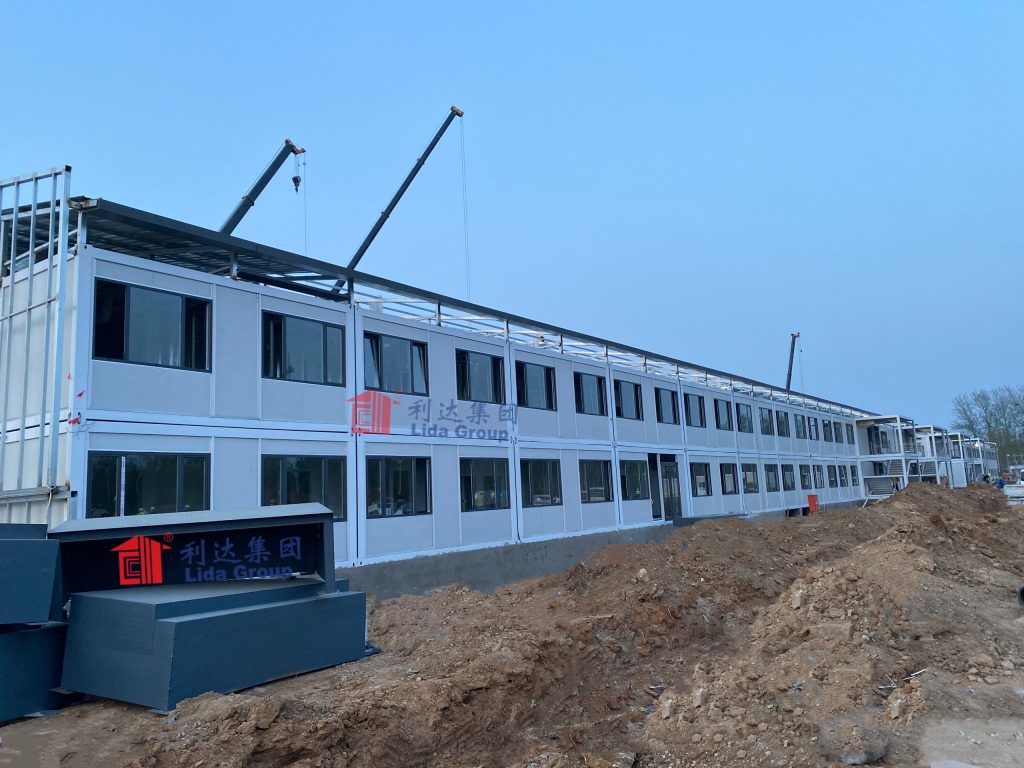
7. Conclusion
The future of on-site accommodation is not just about buildings—it is about intelligent, adaptive spaces that put workers at the center while driving efficiency and sustainability. Lida Group’s smart technology-integrated prefab container units are leading this revolution, proving that on-site housing can be more than just a temporary shelter. By combining IoT sensors, AI control systems, renewable energy, and digital connectivity, Lida Group has created a new standard: accommodation that is comfortable, personalized, and sustainable—even in the world’s harshest remote environments.
The driving forces behind this shift—evolving worker expectations, operational efficiency needs, and sustainability goals—are only growing stronger. As digital natives become the majority of the workforce, as businesses face increasing pressure to cut costs, and as the world races to meet carbon reduction targets, smart on-site accommodation will no longer be an option—it will be a necessity.
Lida Group’s real-world case studies demonstrate the tangible impact of this innovation: workers are healthier and happier, businesses save money and reduce risk, and the industry moves closer to a more sustainable future. The company’s future innovations—from hyper-personalized AI to self-sustaining systems—will push these boundaries even further, creating on-site accommodation that is not just smart, but intuitively human.
In the end, the future of on-site accommodation is about reimagining what remote work can be. It is about recognizing that workers deserve the same level of comfort, connectivity, and dignity wherever they are deployed. Lida Group’s smart prefab containers are not just building this future—they are living proof that it is already here. For workers, businesses, and the planet, this future cannot come soon enough.

Post time: Aug-29-2025
